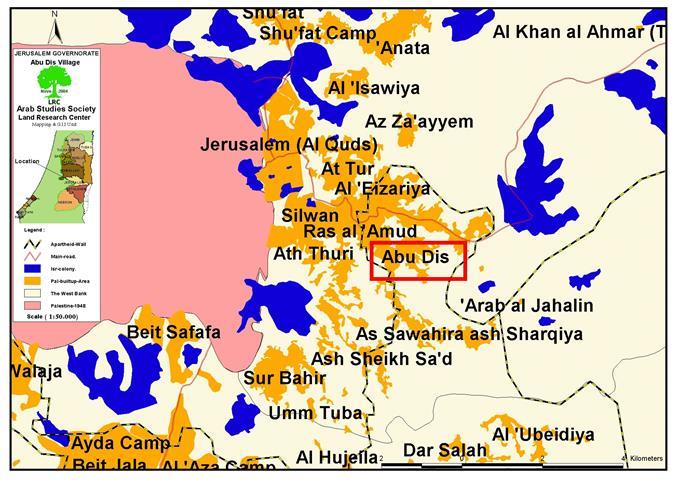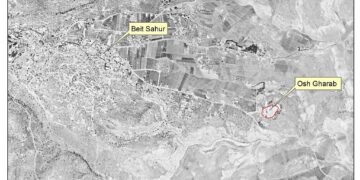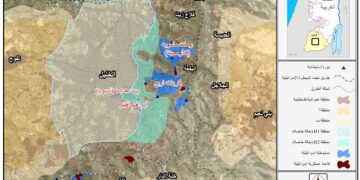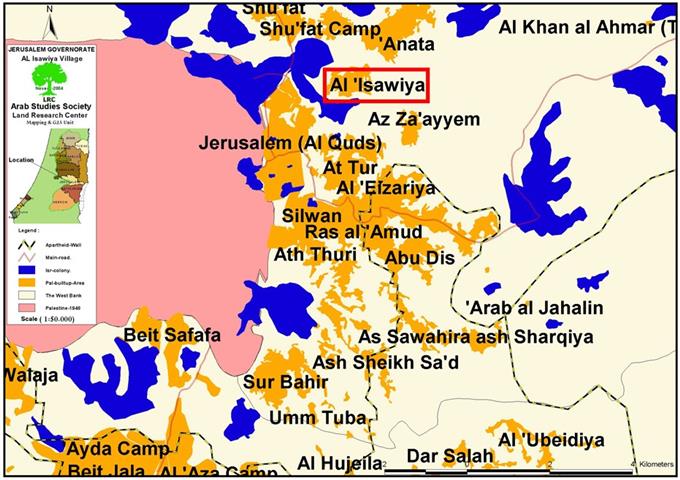Ever since the 1967 War , which resulted in the occupation of the West Bank and Gaza Strip along with other Arab Territories, Israel continued to grab as much Palestinian lands as possible while evicting it of its original owners. That isn't a surprise as the essence and the core of Israel calls for expelling Palestinians from their lands and takes control of it. This principle allows for the usage of any mean possible to reach the goal of land acquisition. Such means include individual and mass killing, land confiscation, house demolition, the policy of eviction and ethnic cleansing in the Palestinian lands.
The above-mentioned policies have been implemented by the Israeli authorities in the West Bank and Gaza Strip, specifically in Jerusalem and Hebron; including them within its Judaization plan. Methods used in Jerusalem to achieve this goal include Zoning, Green Lands, Confiscation for Military Purposes and Public Use and, finally, the Israeli Segregation Wall. Examples of land confiscations in Jerusalem are abundant including the three Latroun villages, Imwas, Yalo, Biet Nuba, the destruction of the Moroccan quarter and Al Sharaf Neighborhood in Jerusalem Old City immediately after the 1967 war to make room for the construction of the Jewish western wall plaza. Other examples include the neighborhoods of Jerusalem such as Hizma and Al Walaja which are facing the threat of the Segregation Wall.
House Eviction Orders in Abu Dis:
For the past year, Israeli Border Police patrols have been going back and forth harassing Palestinian residents of Al Zarazeer Neighborhood of Abu Dis town, especially those living in the vicinity of Cliff Hotel. A total of 40 targeted Palestinian residents, 23 of whom are adults with West Bank ID cards have been continuously harassed. The harassment hasn't stopped for the past three months under the pretext that they carry Palestinian ID cards and, therefore, their presence in their homes in that particular area is illegal, according to the Israeli authorities. The affected Palestinian families hired a lawyer in an attempt to obtain a Jerusalem ID card (locally known as Blue Cards). The lawyer managed only to secure an additional time period (until the end of October 2004) to make the appropriate arrangements regarding their ID cards. After the expiration of the time period, the presence of those who do not have Jerusalem ID cards is considered to be ''illegal'' and are subjected to arrest. The lawyer is currently working on the case as to allow his clients to continue to live in their houses which were built years, even before the occupation took place. These houses include 13 houses built during the Jordanian mandate and therefore have building permits issued in that period of time (Between 1959 and 1962).
In an interview done by LRC filed worker, Mr. Rajeh Ayyad, one of those under the threat of eviction included: 'We are originally from the town of Abu Dis. Our house was legally built in the town before the 1967 War. We used to pay out electricity, water and tax bills based on the fact that we lived in Abu Dis. Today, Israeli forces are taking over Cliff Hotel located near our house as part of constructing the Segregation Wall and trying to evict us from our houses. What logic does this hold? What law explains this?'
In another interview, Mr. Salah Ayyad told his story: 'A month ago, my brother and I were stopped by the Israeli Police border on our way back home in Abu Dis. They prevented us from reaching our house under the pretext that we had to have a ''permit' in order to get to our house.''We assigned a lawyer who contacted the Israeli Civil Administration office to find out that there was a military order states the prevention of Palestinian residents living in the four houses from living in the houses after October 7th, 2004. The time period was extended until the end of October 2004'.
Cliff Hotel:-
Israeli forces invaded Cliff Hotel on April 29th, 2004. The Hotel is owned by Ayyad family and was built in Abu Dis since 1954). In doing so, the Israeli forces had violated the Israeli High Court order which allows owners of the hotel to re-inhabit it while giving the Israeli Border Police the right to use the rooftop of the Hotel on temporary basis and for security reasons. Ayyad family indicated that it paid hundreds of thousands dollars to rehabilitate the Hotel during which the Border Police used to raid the Hotel under the pretext of inspecting ID cards of Palestinian workers.
Head of the Border Police Unit working in the area ordered the demolition of the walls surrounding the Hotel, ravaged the Hotel's park and destroyed some construction works inside the Hotel. It is worth mentioning that Head of the Border Police Unit also testified before the High Court in an attempt to persuade the judges of the Border Police's need to takeover the Hotel under the pretext that it is deserted and it could be used as a shelter and passageway for ''potential Terrorists''. The High Court did not accept this argument and decided that the Border Police can only use the roof to oversee the Wall while allowing Hotel owners to go back and live in it.
Al Qambar Neighborhood:-
A few hundred meters south of Cliff Hotel, Al Qambar Neighborhood (a.k.a Dier Al Sunnah) exists. About 22 families (100 inhabitants, of which 67 are children) live in this neighborhood. It is not strange that one would find mixed ID Cards among family members; i.e. some hold Palestinian ID cards while others hold Jerusalem ID cards.
Mr. Mohammad Hussein, a handicapped man said to LRC field worker: 'Our suffering started upon the establishment of the Israeli checkpoint at Ras Kobsa (at Abu Dis junction). The suffering increased soon after the construction of the Segregation Wall. The climax of the suffering took place in November 2003 when Israeli Border Police shut down the only road connecting our neighborhood with Abu Dis. Captain Ravi, Border Police Commander, promised that he would give a special permit for residents of the neighborhood to be able to reach Jerusalem, especially that it was closed in the face of workers, students and sick people. We, residents of Al Qumbar neighborhood, live in a state of house arrest'
Radwan Family Residents:-
In the vicinity of Al Qambar neighborhood, settlers of – Ateret Kohanim- organization invaded on May 3rd, 2004 the houses Mohammad, Yousef and Osama Khaled Radwan families. They took over the houses and threw their residents outside. According to initial Wall plans, these houses were supposed to be laid outside the Wall. Yet, facing a great deal of pressure by Israeli settlers, Israeli occupation authorities who realigned the route of the Wall as to annex the houses inside of the Wall.
Radawn's family seized house
Photo courtesy of LRC
Kadamat Suhyoon Jewish Settlement:
All the information that has been mentioned earlier in this report (forceful eviction of houses, house arrest of Al Qambar neighborhood residents, closing off road connecting Al Qambar neighborhood with Abu Dis and Jerusalem) were only initial steps to build a new Israeli settlement in Jerusalem called Kadamat Suhyoon (the Feet of Zion). The new settlement is planed to have 280 housing units built over 90 dunums of Abu Dis lands in Umm Al Zarazeer, parcel No. 4. Members of Ateret Kohanim movement tried in the past to plant trees in the parcel as they attempted to use barbed wires to besiege it, yet the Palestinian residents managed to foil their attempt.

Location of Kadamat Zion settlement
Israeli forces, along with the Jewish settlers assume that the construction of the Segregation Wall is a doorway to the new settlement to be built. A visit paid by the Director of the Israeli Land Administration and the Director General of the Israeli defense ministry to the site (Al Qambar neighborhood) during the second half of October 2004, encouraged Jewish setters to go on with their violations.
Furthermore, Israeli sources recently confirmed that Jerusalem municipality had finished compiling plans for this new settlement and that the actual work will start once the construction of the Segregation Wall is completed.
Prepared by
The Land Research Center
LRC















